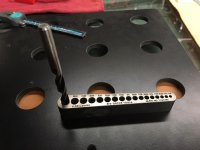Oops! I see I was a day late.
They say, “A picture is worth a thousand words.” This post would have been a lot longer without the images. [eek]
Last night I took an old holesaw that I’ve used many times to cut cable access to a work top. The hardware is 2” nominal and I think this saw is 2-1/8”.
You will probably find more uses for this size than 1-3/4”.
It is no longer sharp enough to use effectively on plywood, though it is OK for MDF and particle board.
You can introduce operator error by rocking the saw from side to side while drilling. That will result in an enlarged pilot hole which will make registration on the second side iffy.
There are two ways to avoid this: Either drill the pilot hole in advance using a guide as shown in the post above, or as I did, drill in a drill press. For a table top, you will probably have to use the pilot hole method, per Cheese’s post.
The photo labeled #1, was my first cut. I drilled until the pilot drill was exposed.
The photo labeled #2, was my second cut from the opposite side.
The hockey puck was the piece I pulled from the hole saw. Note the parting line.
The dull blade cut so slowly that it generated enough heat to melt the glue in the plywood. It really was not suitable for plywood and a new blade would make a cleaner cut.
If you go with one of the cable pass through devices, this all becomes moot as they include a grommet to hide the cut edges.
The “hockey puck” waste shows the parting line roughly in the middle. The hole will also have some of the same.
Additional notes:
The Gator drill guide is the Steinway of the drill guides. If you are going to use it often (especially if you don’t have a drill press), then it is probably the way to go.
Milescraft and Kreg make much less expensive versions using an injection molded base with steel drill bushings. I have the Milescraft version and it is entirely competent.
As a side note: It is impossible to get a suitable interior bore finish for these devices. Zinc plating will not “reach” inside a bore. Nickel plating will, but nickel is so soft that it will abrade off the first time you use it.
There are two approaches to deal with this issue. The first is to wrap it with an oily rag when you are done with it—but that can be messy.
The second is to use a vapor emitting, rust preventive paper, poly bag or poly tubing. U-Line and Amazon carry versions of this.
The simplest way is to lay a sheet of this paper in your Systainer. You can attach it to the walls, bottom or top.
The sheets emit a (perfectly safe) vapor that combines with the oxygen in the box; the deficit of free oxygen molecules means that oxygen is not available to oxidize (rust) the tools.
But note that these sheets only work if the container is typically in the closed condition, and eventually the paper has to be replaced after most of the vapor has been released. The vapor is heavier than air, so it will last a long time in a container that is accessed from the top.
When I was still working, we used these vapor emitting sheets regularly. They resemble heavy brown kraft paper. They were perfectly capable of solving our rust problem when we shipped unfinished steel goods to the metal finisher. We ordered directly from the manufacturer, but minimums apply there. I think Uline or Amazon would be a better source for this stuff if you don’t use large quantities.
Here are some of the vapor emitting products:
https://www.uline.com/Grp_89/VCI-Pr...5xNmB27Q-TOGgNiAy3fq2VUOs1KpkXqIaAqbREALw_wcB
Here is my search for cable pass through hardware. Most are made from resin. The correct hole size will be specified on the packaging.
https://www.google.com/search?q=cable+pass+through+desk+plate&client=firefox-b-1-m&sca_esv=fbc34415c57d9a54&sxsrf=ADLYWIJMYsqApmgiv-b89zLJHy__3punBA%3A1728303265871&ei=odADZ5ffNL-X5OMP4pTyoA8&ved=0ahUKEwjXs-exn_yIAxW_C3kGHWKKHPQQ4dUDCA8&oq=cable+pass+through+desk+plate&gs_lp=Egxnd3Mtd2l6LXNlcnAiHWNhYmxlIHBhc3MgdGhyb3VnaCBkZXNrIHBsYXRlMggQIRigARjDBDIIECEYoAEYwwRIuOUBULQxWKqxAXADeAGQAQGYAZ4LoAHiNKoBDzAuNS4xLjIuMC4yLjAuM7gBDMgBAPgBAZgCDKACvR_CAgoQABiwAxjWBBhHwgINEAAYgAQYsAMYQxiKBcICBxAjGLACGCfCAgcQABiABBgNwgIGEAAYBxgewgIIEAAYBxgIGB7CAggQABgFGAcYHsICChAAGAcYCBgeGA_CAggQABgHGB4YD8ICCxAAGIAEGJECGIoFwgIIEAAYBRgNGB7CAgoQABgFGA0YHhgPwgIIEAAYCBgNGB7CAgsQABiABBiGAxiKBcICChAhGKABGMMEGAqYAwCIBgGQBgqSBw0zLjMuMy4xLjYtMS4xoAfQYQ&sclient=gws-wiz-serp






